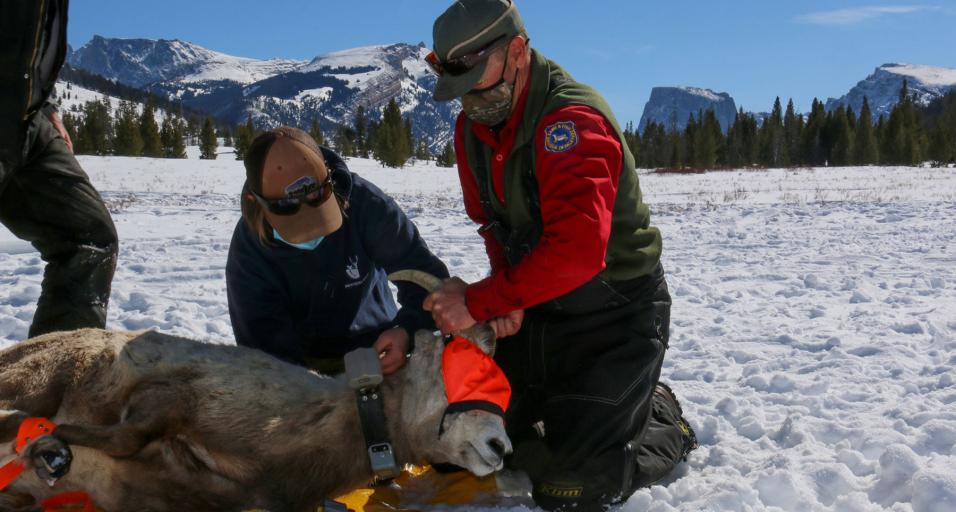The Wyoming Game and Fish Department and University of Wyoming recently expanded their statewide on-going research on bighorn sheep by capturing and collaring 14 animals from the Whiskey Mountain herd north of Pinedale. The female bighorn sheep were captured for disease sampling, body condition measurements and fitted with GPS collars and vaginal implant transmitters to learn more about adult and lamb survival, nutritional condition, migration patterns and the potential presence of disease.
University of Wyoming wildlife researchers Dr. Kevin Monteith (L) and graduate student Brittany Wagler weigh a ewe bighorn sheep captured near Green River lakes north of Pinedale recently.
Biological samples were collected to test for respiratory pathogens that can cause pneumonia. Researchers from the Wyoming Cooperative Fish & Wildlife Research Unit at the University of Wyoming performed an ultrasound on each animal to measure body fat, which showed these animals in relatively good body condition compared to other bighorns in the state. This is part of a multi-year study evaluating how body condition is related to pneumonia outbreaks, which has plagued the Whiskey Mountain Bighorn Sheep (WMBS) herd.
Most of the WMBS herd winters on the north and east side of the Wind River Range near Dubois, which has been in decline for decades. However, a portion of this herd stays on the west side of the divide, utilizing wind-swept slopes on the high peaks surrounding Green River lakes north of Pinedale. Each year, Pinedale Wildlife Biologist Dean Clause typically counts approximately 150 animals in this segment and these animals seem to be holding steady while the rest of the herd continues to decline. Wildlife managers are trying to learn why the two herd segments are faring differently.
University of Wyoming graduate student Rachel Smiley holds a GPS collar that will be fitted to the ewe bighorn sheep in her lap. The collars will provide location data for the next 2.5 years.
The WMBS herd has been an important part of bighorn sheep management in Wyoming and other western states for many decades, recognized for years as the largest congregation of wintering bighorn sheep in the country. On several occasions, from 1949 through 1995, bighorns from the WMBS herd were used to establish new bighorn sheep herds or augment existing herds throughout the West.
Following a large, all-age die-off caused by pneumonia during the winter of 1990-1991 the WMBS herd has consistently experienced low lamb production leading to continued population decline. Observations of the bighorn sheep herd over the past three decades has shown the persistence of bighorn sheep (lambs and adults) exhibiting nasal discharge, coughing, parasites, viral infections and low body mass. All of these symptoms indicate bighorn sheep in the herd are generally unhealthy, likely subject to environmental stressors and continually exposed to contagious or transmissible pathogens and parasites.
Dr. Kevin Monteith reads an ultrasound monitor to determine pregnancy and measure fetal development on a ewe bighorn sheep. Researchers also use the ultrasound to measure body fat to help determine overall body condition.
Of the 14 ewe bighorn sheep captured in the upper Green River, four were noted to have visible nasal discharge typical of an animal with pnuemonia. Nasal and tonsil swabs, along with a blood sample, were collected on each animal. It was determined that 12 of the14 animals were pregnant and received a vaginal implant transmitter (VIT). The VIT will be expelled when the ewe gives birth in late-May or early-June, sending a signal and location back to researchers who will then try to find the newborn lamb to collect biological samples and fit it with an expandable collar to monitor its movements and survival.
A professional wildlife capture crew brings in two captured ewe bighorn sheep that will be swapped out for two newly-collared ewes that will be ferried back to their capture location.
Game and Fish Pinedale Wildlife Coordinator Brandon Scurlock takes measurements before collaring a ewe bighorn sheep near the lower Green River Lake north of Pinedale recently.
A helicopter ferries two newly-collared bighorn ewes over the iconic Squaretop Mountain on their way back to their capture location in the Wind River mountains north of Pinedale.
Bighorn Sheep of the Wind River Range Captured and Collared
Mark Gocke, Public Information Specialist, 307-249-5811



